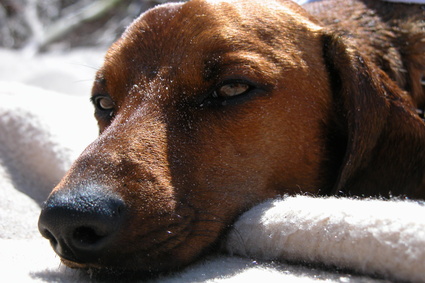Here's some great dog exercise tips that will keep both dog and owner fit and healthy and in good shape.
Cycling
Walking alongside your bicycle, especially trotting, whereby your dog moves its left hind leg and right front leg (and vice versa) at the same time, is ideal physical exercise. The movements are in a straight line and your dog gets optimal use of its muscles, which promotes muscular development. This is frequently done in some parts of the world but in some areas it is not allowed if the dog is on the leash, since this would restrict your control of the bike.
Where it is possible to let the dog run off the leash behind the bicycle, it should be no problem. It is often said that a dog must not walk beside a bicycle before its first birthday, but this is only partly true. If you only cycle for short distances and adjust your speed to that of the dog, you can begin with this when the dog is six months old.
Always adjust your speed to suit the dog and prevent it from becoming tired. Gradually build up the cycle trips and, along with this, the condition of your dog. An athlete would not be able to run a marathon straight after the winter break without getting injured, and the same applies for your dog.
For reasons of safety, teach your dog right from the beginning that it must always run on the curb side of the bicycle. It goes without saying that, before you start to cycle with your dog, it must be well socialized and perfectly under (voice) control. If it suddenly lunges out at another dog or jumps to one side because it is frightened by something, both you and the dog will be endangered, as well as other road users.
Many bicycle trips are on asphalt roads. Remember that asphalt can get very hot in the summer, painfully damaging your dog's pads, and it will take a long time for such an injury to heal. In addition to this, a dog has the tendency to go on, even when it really cannot. The combination of over exertion and heat is not good for any dog, but for Huskies and some Mastiffs can cause acute and dangerous conditions. Therefore, cycle only in moderate temperatures, and only in the mornings and evenings at the height of the summer.
Swimming
On hot, summer days, swimming is ideal exercise. The dog uses all its muscles and is not likely to injure itself in the water. Many dogs love water by nature and can hardly pass alongside a pool or lake without taking a dip. Other dogs need a bit more encouragement.
You can teach your dog to swim by going into the water with it and supporting it under the breast and belly when it has no contact with the ground. If your dog loves to retrieve, you can throw a retrieving block into the water, throwing it a bit further every time, so that it gradually acclimatizes. Never just push the dog into the water. This Spartan method only encourages fear of water and will also cause your dog to have less confidence in you.
Water which is unsafe for humans because of dangerous bacteria, or because there are unpredictable undercurrents, is also unsafe for dogs. Only allow your dog to swim in safe places. It can become entangled in fishing nets and trailing water plants, so be careful with your dog in those areas. Finally, ensure that it can get out of the water without too much difficulty; steeply sloping banks can be impossible to climb for many dogs.

 What to Expect From a Holistic Veterinarian
Some dog owners choose to take natu
What to Expect From a Holistic Veterinarian
Some dog owners choose to take natu
 Signs of a Dog That Has Lost Her Litter of Puppies
Signs of a Dog That Has Lost Her Litter of Pup
Signs of a Dog That Has Lost Her Litter of Puppies
Signs of a Dog That Has Lost Her Litter of Pup
 Dog Insurance With Pre-Existing Conditions
Dog Insurance With Pre-Existing Conditions
Dog Insurance With Pre-Existing Conditions
Dog Insurance With Pre-Existing Conditions
 Causes of Mammary Enlargement in Dogs
When a bitch goes through a false p
Causes of Mammary Enlargement in Dogs
When a bitch goes through a false p
 Understanding Teething in Puppies
Understanding Teething in Puppies
Understanding Teething in Puppies
Understanding Teething in Puppies